Enhanced Properties of Ti/Al Laminated Composite Reinforced by High-Entropy Alloy Particles
Abstract
:1. Introduction
2. Experimental Procedure
2.1. Materials Preparation
2.2. Microstructure Characterization
2.3. Mechanical Testing Methods
3. Results and Discussion
3.1. Morphologies of HEA Particles and XRD Patterns
3.2. SEM Morphologies
3.3. TEM Results
3.4. EBSD Characterization
3.5. Tensile Testing
3.5.1. Macroscopic Fracture Morphology and Tensile Curves
3.5.2. Tensile Fracture Morphologies
3.6. Compression Testing
3.6.1. Compression Results under Load Perpendicular to the Layer
3.6.2. Compression Results under Load Parallel to the Layer
3.7. Strengthening Mechanism
4. Conclusions
- The interfaces of HEAp-Ti/Al laminated composites exhibit strong bonding. Additionally, the intermetallic compound Al3Ti is evenly distributed throughout the original Al layer.
- TEM analysis revealed the presence of numerous dislocations at the interfacial region of the intermetallic compound Al3Ti and Al. Furthermore, EBSD analysis indicated the occurrence of Al3Ti deformation in the interface area between the Ti layer and the reaction layer.
- The results of the tensile test indicated that the HEAp-Ti/Al laminated composites had an average tensile strength of 258 MPa and an average yield strain of 9.86%. Upon observing the tensile fracture, it was observed that the Ti layer failed through plastic fracture, presenting dimples. On the other hand, the reaction layer exhibited both brittle and ductile fractures. The HEA particles showed brittle fracture characteristics.
- The results of the compressive test indicate that a significant number of microcracks are formed in the reaction layer when the load is applied perpendicular to the layer. This occurrence is advantageous in enhancing the material properties. When the load is applied parallel to the layer, material failure mainly occurs through interfacial debonding.
Author Contributions
Funding
Data Availability Statement
Conflicts of Interest
References
- Vecchio, K.S. Synthetic multifunctional metallic-intermetallic laminate composites. JOM 2005, 57, 25–31. [Google Scholar] [CrossRef]
- Wang, H.; Zhu, C.; Vecchio, K.S. Deformation and fracture evolution of FeAl-based metallic-intermetallic laminate (MIL) composites. Acta Mater. 2020, 194, 496–515. [Google Scholar] [CrossRef]
- Kattner, U.R.; Lin, J.C.; Chang, Y.A. Thermodynamic Assessment and Calculation of the Ti-Al System. Metall. Mater. Trans. A 1992, 23, 2081–2090. [Google Scholar] [CrossRef]
- Jafari, R.; Eghbali, B.; Adhami, M. Influence of annealing on the microstructure and mechanical properties of Ti/Al and Ti/Al/Nb laminated composites. Mater. Chem. Phys. 2018, 213, 313–323. [Google Scholar] [CrossRef]
- Lazurenko, D.V.; Lozanov, V.V.; Stark, A.; Pyczak, F.; Ruktuev, A.A.; Emurlaev, K.I.; Song, L.; Bataev, I.A.; Ivanov, I.V.; Ogneva, T.S.; et al. In situ synchrotron X-ray diffraction study of reaction routes in Ti-Al3Ti-based composites: The effect of transition metals on L12 structure stabilization. J. Alloys Compd. 2021, 875, 160004. [Google Scholar] [CrossRef]
- Lazurenko, D.V.; Petrov, I.Y.; Mali, V.I.; Esikov, M.A.; Kuzmin, R.I.; Lozanov, V.V.; Pyczak, F.; Stark, A.; Dovzhenko, G.D.; Bataev, I.A.; et al. Ti-Al3Ti metal-intermetallic laminate (MIL) composite with a cubic titanium trialuminide stabilized with silver: Selection of fabrication regimes, structure, and properties. J. Alloys Compd. 2022, 916, 165480. [Google Scholar] [CrossRef]
- Price, R.D.; Jiang, F.; Kulin, R.M.; Vecchio, K.S. Effects of ductile phase volume fraction on the mechanical properties of Ti-Al3Ti metal-intermetallic laminate (MIL) composites. Mater. Sci. Eng. A 2011, 528, 3134–3146. [Google Scholar] [CrossRef] [Green Version]
- Zhou, P.; Guo, C.; Wang, E.; Wang, Z.; Chen, Y.; Jiang, F. Interface tensile and fracture behavior of the Ti/Al3Ti Metal-Intermetallic Laminate (MIL) composite under quasi-static and high strain rates. Mater. Sci. Eng. A 2016, 665, 66–75. [Google Scholar] [CrossRef]
- Harach, D.J.; Vecchio, K.S. Microstructure evolution in metal-intermetallic laminate (MIL) composites synthesized by reactive foil sintering in air. Metall. Mater. Trans. A Phys. Metall. Mater. Sci. 2001, 32, 1493–1505. [Google Scholar] [CrossRef]
- Mirjalili, M.; Soltanieh, M.; Matsuura, K.; Ohno, M. On the kinetics of TiAl3 intermetallic layer formation in the titanium and aluminum diffusion couple. Intermetallics 2013, 32, 297–302. [Google Scholar] [CrossRef]
- Yu, S.; Zhipeng, W.; Lianxi, H.; Binghua, W.; Taiqing, D. Characterization on solid phase diffusion reaction behavior and diffusion reaction kinetic of Ti/Al. Rare Met. Mater. Eng. 2017, 46, 2080–2086. [Google Scholar] [CrossRef]
- Rohatgi, A.; Harach, D.J.; Vecchio, K.S.; Harvey, K.P. Resistance-curve and fracture behavior of Ti-Al3Ti metallic-intermetallic laminate (MIL) composites. Acta Mater. 2003, 51, 2933–2957. [Google Scholar] [CrossRef]
- Adharapurapu, R.R.; Vecchio, K.S.; Jiang, F.; Rohatgi, A. Effects of ductile laminate thickness, volume fraction, and orientation on fatigue-crack propagation in Ti-Al3Ti metal-intermetallic laminate composites. Metall. Mater. Trans. A Phys. Metall. Mater. Sci. 2005, 36, 1595–1608. [Google Scholar] [CrossRef]
- Wang, E.; Guo, C.; Zhou, P.; Lin, C.; Han, X.; Jiang, F. Fabrication, mechanical properties and damping capacity of shape memory alloy NiTi fiber-reinforced metal-intermetallic-laminate (SMAFR-MIL) composite. Mater. Des. 2016, 95, 446–454. [Google Scholar] [CrossRef]
- Han, Y.; Que, Q.; Cheng, R.; Lin, C.; Han, W.; Wang, E.; Zhu, J.; Yan, H. Microstructure Evolution and Mechanical Performances of SiCf Reinforced (Al3Ti + Al3Ni)-Based Metallic-Intermetallic Laminate Composite. Met. Mater. Int. 2021, 27, 4035–4046. [Google Scholar] [CrossRef]
- Vecchio, K.S.; Jiang, F. Fracture toughness of Ceramic-Fiber-Reinforced Metallic-Intermetallic-Laminate (CFR-MIL) composites. Mater. Sci. Eng. A 2016, 649, 407–416. [Google Scholar] [CrossRef]
- Cui, L.; Ma, B.; Feng, S.Q.; Wang, X.L. Microstructure and Mechanical Properties of High-Entropy Alloys CoCrFeNiAl by Welding. Adv. Mater. Res. 2014, 936, 1635–1640. [Google Scholar] [CrossRef]
- YWang, P.; Li, B.S.; Ren, M.X.; Yang, C.; Fu, H.Z. Microstructure and compressive properties of AlCrFeCoNi high entropy alloy. Mater. Sci. Eng. A 2008, 491, 154–158. [Google Scholar]
- Yeh, J.W.; Chen, S.K.; Lin, S.J.; Gan, J.Y.; Chin, T.S.; Shun, T.T.; Tsau, C.H.; Chang, S.Y. Nanostructured High-Entropy Alloys with Multiple Principal Elements: Novel Alloy Design Concepts and Outcomes. Adv. Eng. Mater. 2004, 6, 299–303. [Google Scholar] [CrossRef]
- Zhang, Y.; Zuo, T.T.; Tang, Z.; Gao, M.C.; Dahmen, K.A.; Liaw, P.K.; Lu, Z.P. Microstructures and properties of high-entropy alloys. Prog. Mater. Sci. 2014, 61, 1–93. [Google Scholar] [CrossRef]
- Li, Q.; Zhao, S.; Bao, X.; Zhang, Y.; Zhu, Y.; Wang, C.; Lan, Y.; Zhang, Y.; Xia, T. Effects of AlCoCrFeNiTi high-entropy alloy on microstructure and mechanical properties of pure aluminum. J. Mater. Sci. Technol. 2020, 52, 1–11. [Google Scholar] [CrossRef]
- Wang, H.; Ren, W.; Li, G.; Wen, H.; Wang, C.; Chen, J.; Zhao, Y.; Chen, G.; Kai, X. Microstructure and properties of FeCoNi1.5CrCu/2024Al composites prepared by microwave sintering. Mater. Sci. Eng. A 2021, 801, 140406. [Google Scholar] [CrossRef]
- Rios, M.L.; Baldevenites, V.L.; Voiculescu, I.; Rosca, J.M. AlCoCrFeNi High Entropy Alloys as Possible Nuclear Materials. Microsc. Microanal. 2020, 26, 406–407. [Google Scholar] [CrossRef]
- Du, L.M.; Lan, L.W.; Zhu, S.; Yang, H.J.; Shi, X.H.; Liaw, P.K.; Qiao, J.W. Effects of temperature on the tribological behavior of Al0.25CoCrFeNi high-entropy alloy. J. Mater. Sci. Technol. 2019, 35, 917–925. [Google Scholar] [CrossRef]
- Liu, Y.; Chen, J.; Li, Z.; Wang, X.; Fan, X.; Liu, J. Formation of transition layer and its effect on mechanical properties of AlCoCrFeNi high-entropy alloy/Al composites. J. Alloys Compd. 2019, 780, 558–564. [Google Scholar] [CrossRef]
- Wang, Q.; Zeng, L.; Gao, T.; Du, H.; Liu, X. On the room-temperature tensile deformation behavior of a cast dual-phase high-entropy alloy CrFeCoNiAl0.7. J. Mater. Sci. Technol. 2021, 87, 29–38. [Google Scholar] [CrossRef]
- Zhao, C.; Li, J.; Liu, Y.; Ma, X.; Jin, Y.; Wang, W.Y.; Kou, H.; Wang, J. Optimizing mechanical and magnetic properties of AlCoCrFeNi high-entropy alloy via FCC to BCC phase transformation. J. Mater. Sci. Technol. 2021, 86, 117–126. [Google Scholar] [CrossRef]
- Niu, S.; Kou, H.; Zhang, Y.; Wang, J.; Li, J. The characteristics of serration in Al0.5CoCrFeNi high entropy alloy. Mater. Sci. Eng. A 2017, 702, 96–103. [Google Scholar] [CrossRef]
- Yang, H.; Li, J.; Pan, X.; Wang, W.Y.; Kou, H.; Wang, J. Nanophase precipitation and strengthening in a dual-phase Al0.5CoCrFeNi high-entropy alloy. J. Mater. Sci. Technol. 2021, 72, 1–7. [Google Scholar] [CrossRef]
- Li, Z.; Zhang, Y.; Xiong, H.; Kong, C.; Yu, H. Fabrication of particle-reinforced aluminum alloy composite: Role of casting and rolling. Mater. Manuf. Process. 2022, 37, 90–98. [Google Scholar] [CrossRef]
- Zhang, Y.; Luo, K.; Lei, G.; Yu, H. Interfacial Characteristics and Enhanced Mechanical Properties of Al0.5CoCrFeNi High-Entropy Alloy Particles Reinforced Al Matrix Composites. Metall. Mater. Trans. A 2022, 53, 4161–4167. [Google Scholar] [CrossRef]
- Qin, L.; Fan, M.; Guo, X.; Tao, J. Plastic deformation behaviors of Ti-Al laminated composite fabricated by vacuum hot-pressing. Vacuum 2018, 155, 96–107. [Google Scholar] [CrossRef]
- Huang, M.; Xu, C.; Fan, G.; Maawad, E.; Gan, W.; Geng, L.; Lin, F.; Tang, G.; Wu, H.; Du, Y.; et al. Role of layered structure in ductility improvement of layered Ti-Al metal composite. Acta Mater. 2018, 153, 235–249. [Google Scholar] [CrossRef]
- Fan, M.; Domblesky, J.; Jin, K.; Qin, L.; Cui, S.; Guo, X.; Kim, N.; Tao, J. Effect of original layer thicknesses on the interface bonding and mechanical properties of TiAl laminate composites. Mater. Des. 2016, 99, 535–542. [Google Scholar] [CrossRef] [Green Version]
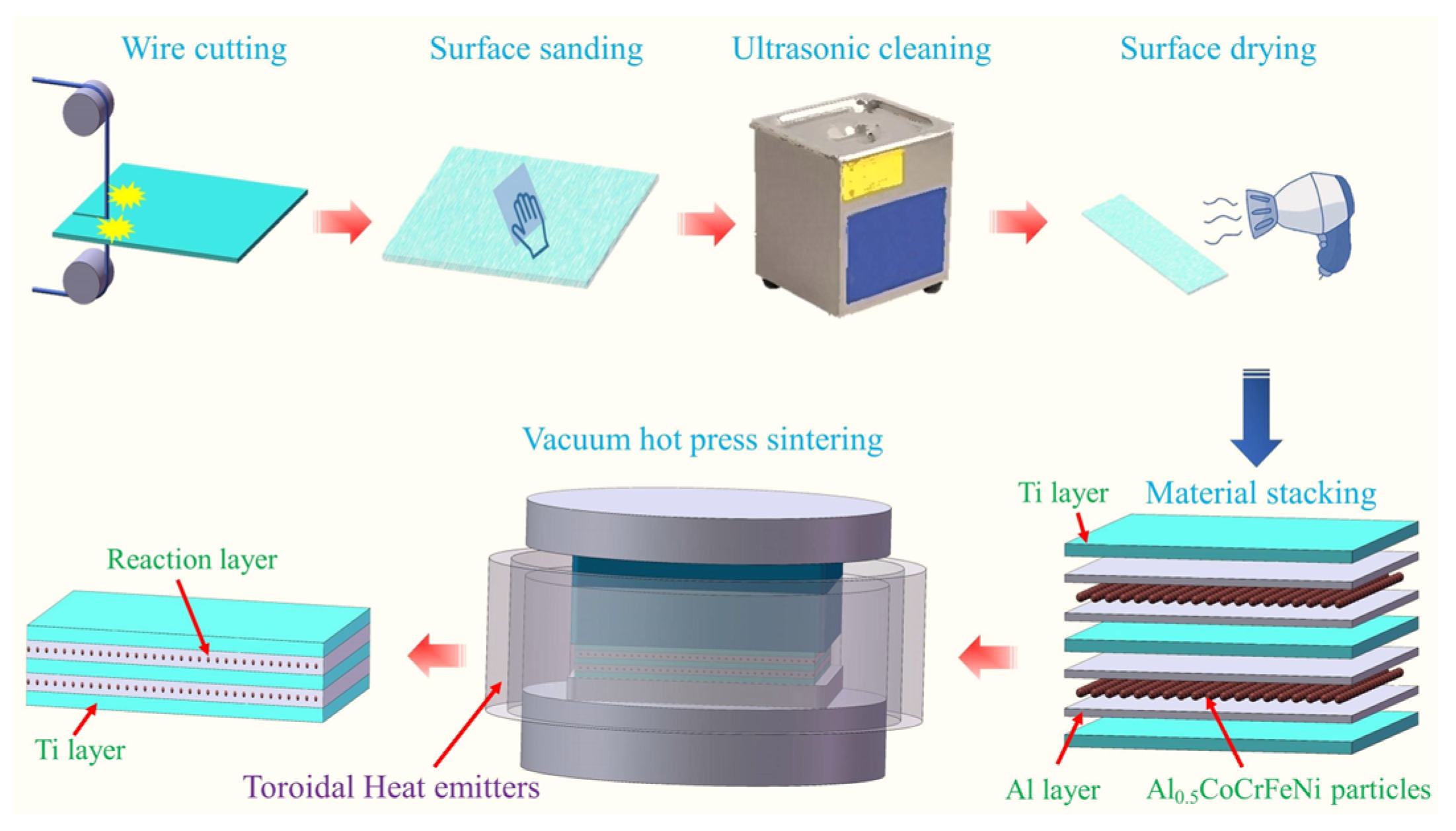
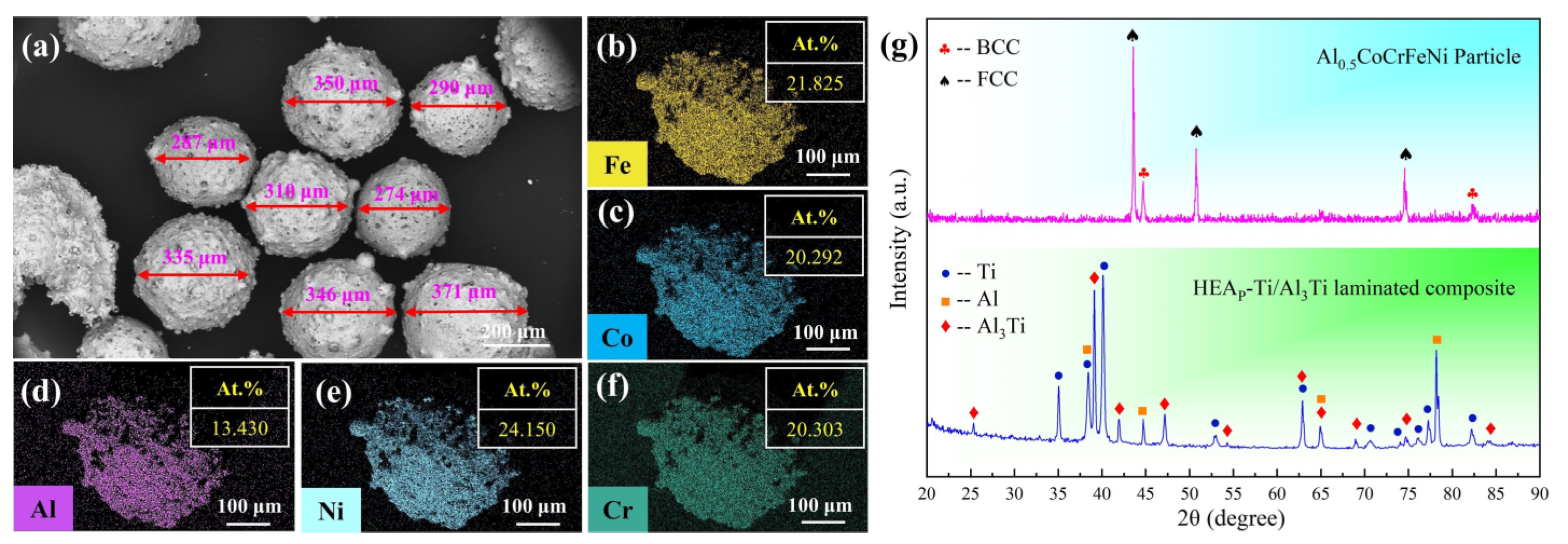
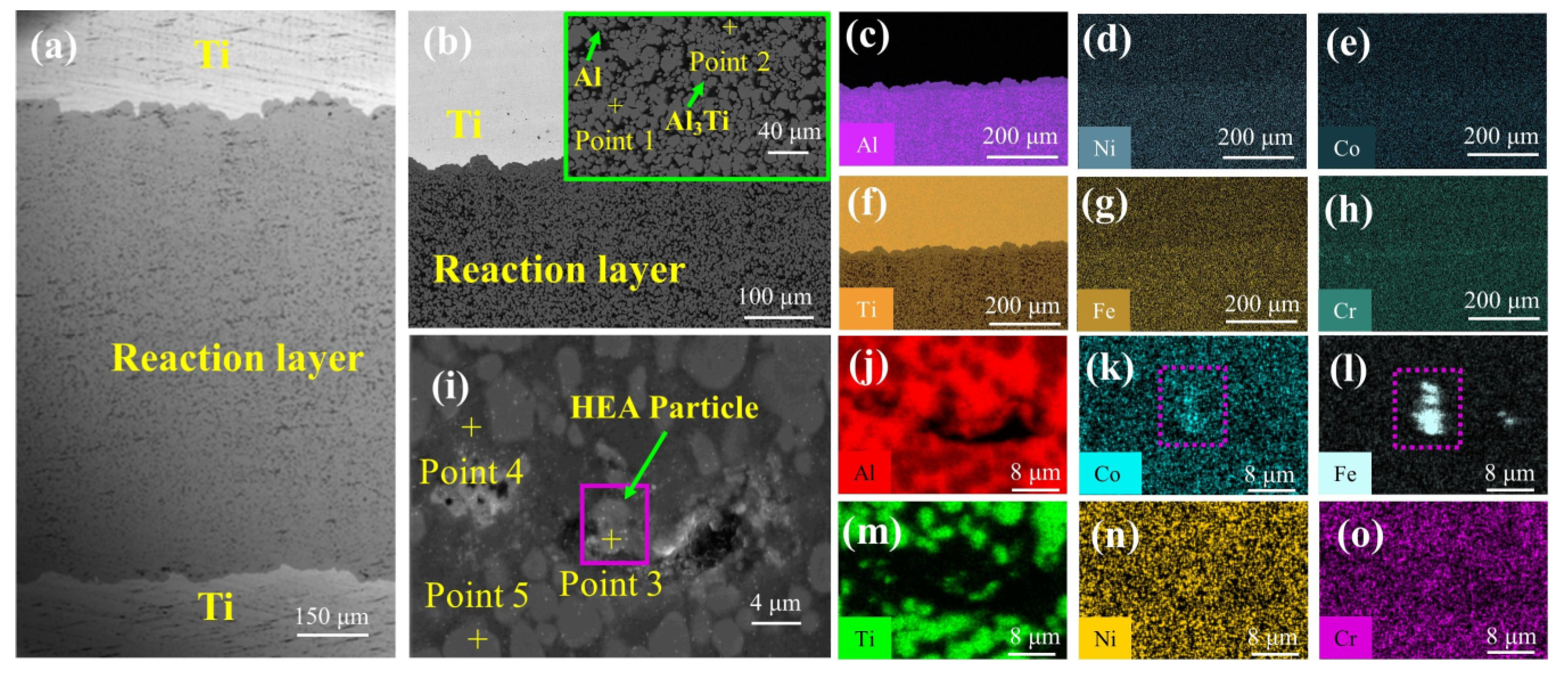


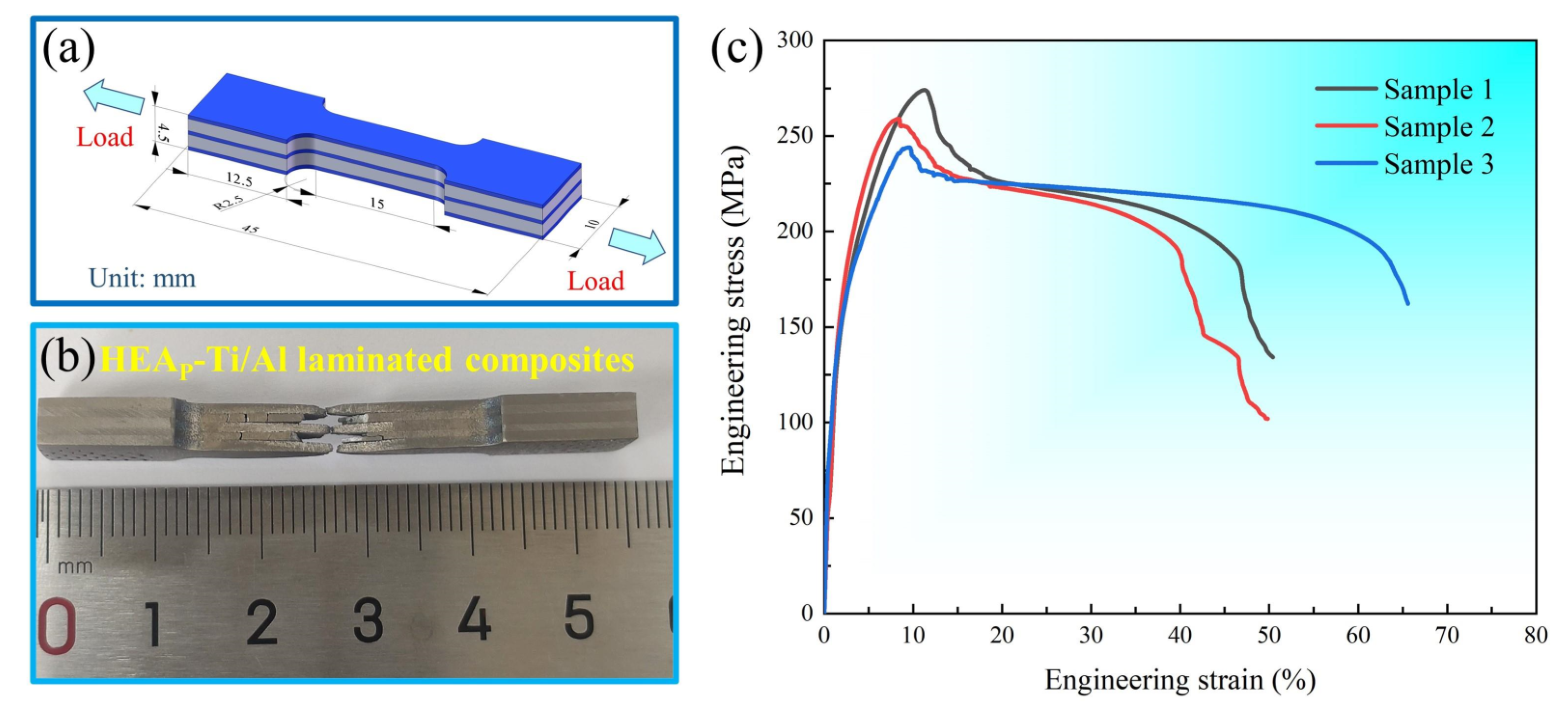
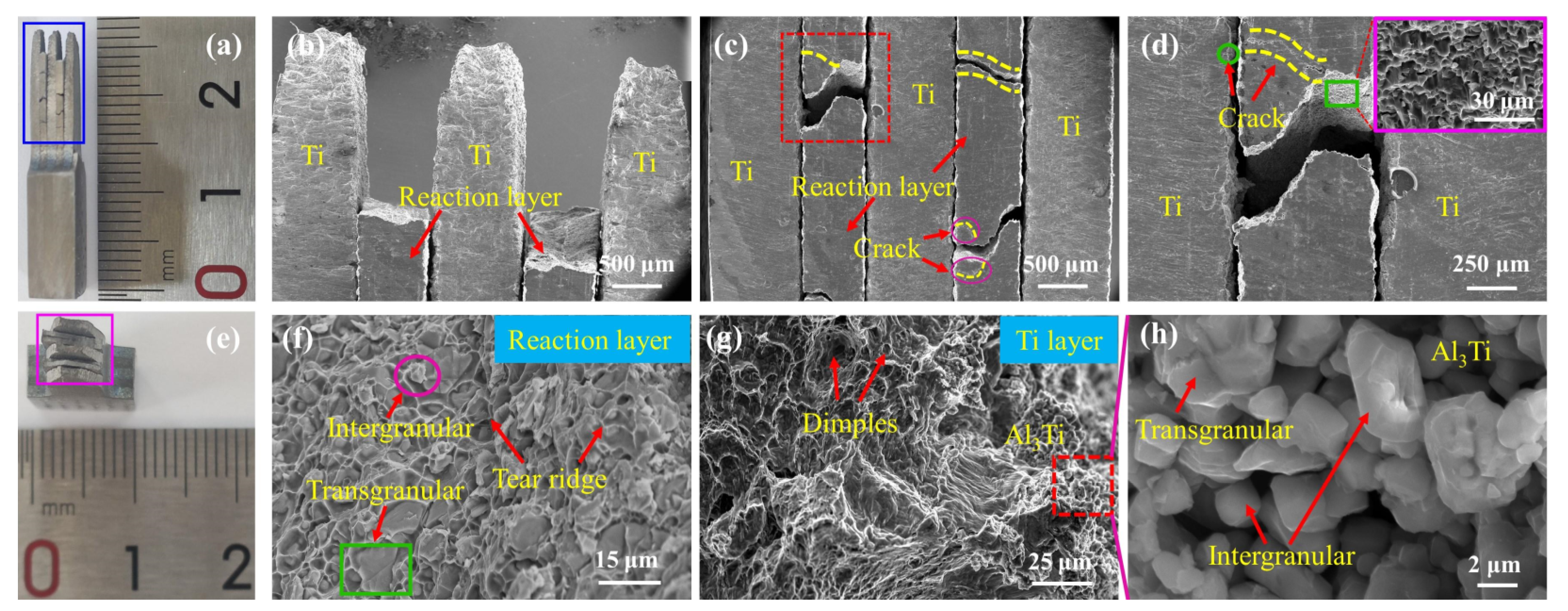

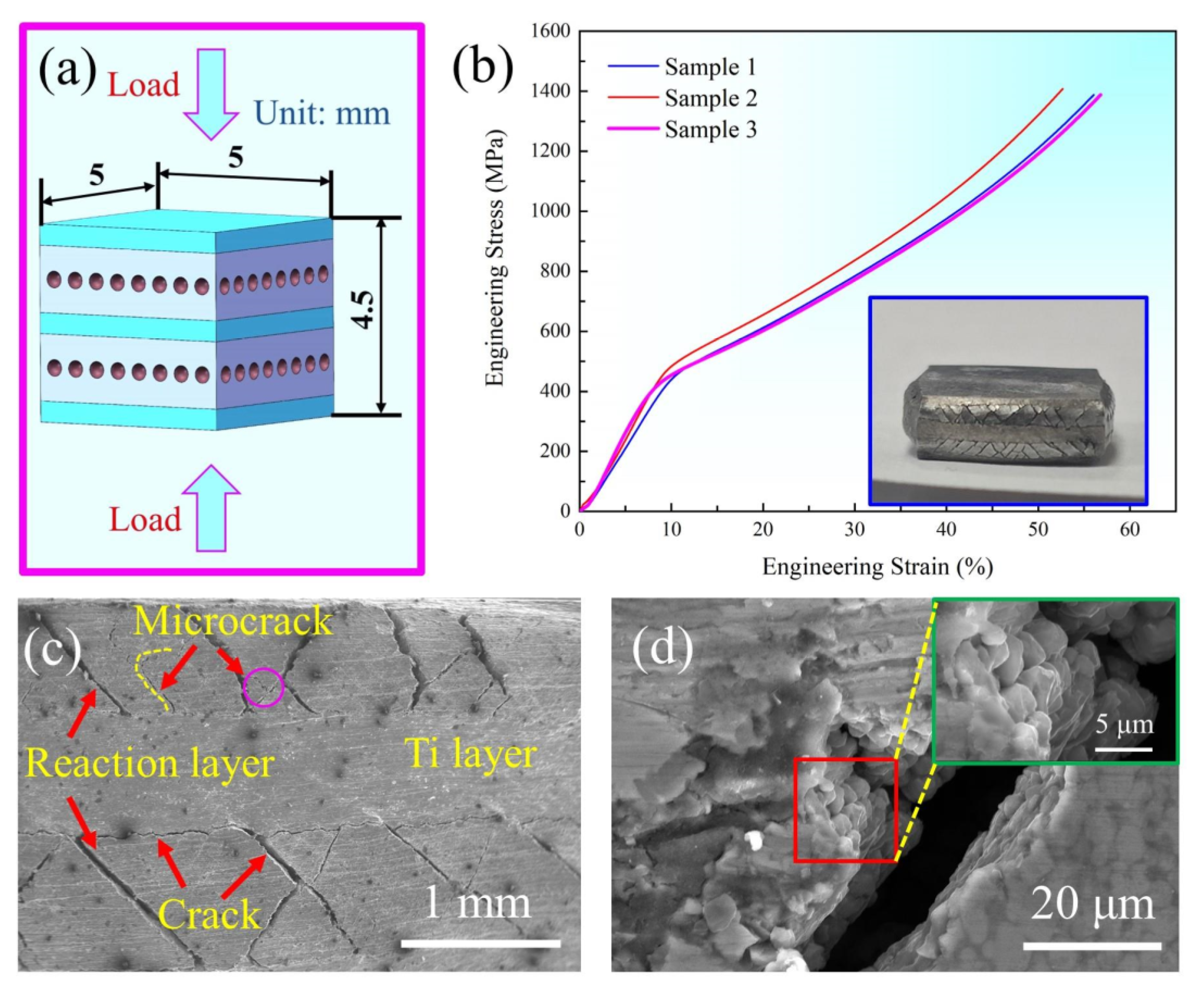
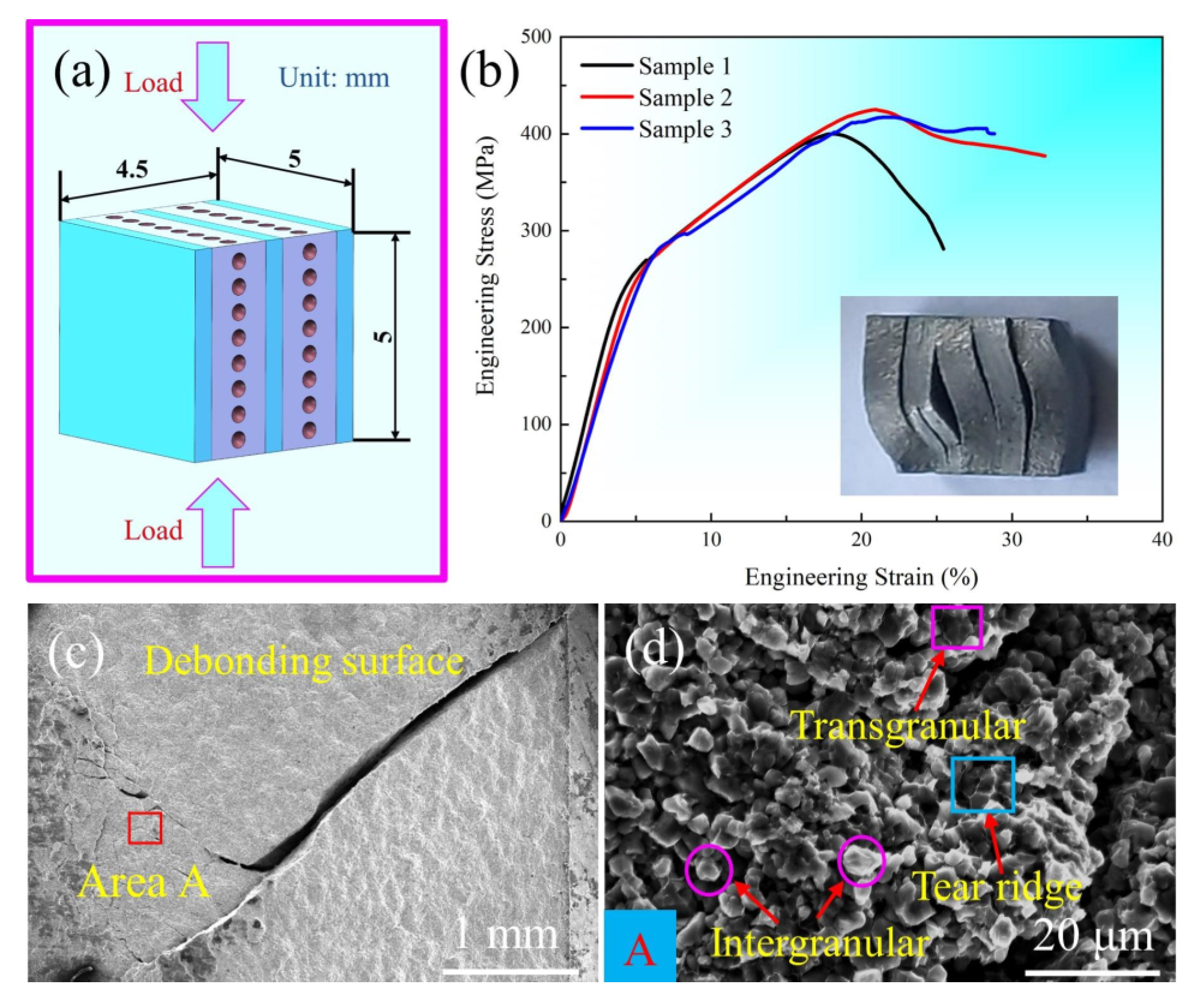

| Materials | Compositions (wt %) |
|---|---|
| 1060 Al | Al: balance, Fe: 0.35, Si: 0.25, Cu: 0.05, Mn: 0.03, Mg: 0.03, Zn: 0.05, V: 0.05, Ti: 0.03 |
| TA1 | Ti: balance, Fe: 0.15, O: 0.15, C: 0.05, Si: 0.1, H: 0.0015, N: 0.03 |
| HEA Particles | Al: balance, Fe: 22.11, Co: 23.35, Cr: 20.63, Ni: 23.32 |
| Position | Atomic Ratio of Each Element (%) |
|---|---|
| Point 1 | Al: 97.181; Ti: 2.819 |
| Point 2 | Al: 74.744; Ti: 25.256 |
| Point 3 | Al: 76.81; Cr: 0.02; Fe: 22.62; Co: 0.36; Ni: 0.18 |
| Point 4 | Al: 98.342; Ti: 1.658 |
| Point 5 | Al: 75.628; Ti: 24.372 |
Disclaimer/Publisher’s Note: The statements, opinions and data contained in all publications are solely those of the individual author(s) and contributor(s) and not of MDPI and/or the editor(s). MDPI and/or the editor(s) disclaim responsibility for any injury to people or property resulting from any ideas, methods, instructions or products referred to in the content. |
© 2023 by the authors. Licensee MDPI, Basel, Switzerland. This article is an open access article distributed under the terms and conditions of the Creative Commons Attribution (CC BY) license (https://creativecommons.org/licenses/by/4.0/).
Share and Cite
Wang, E.; Lv, L.; Kang, F.; Li, S.; Li, J.; Tian, Y.; Jiang, W.; Song, X. Enhanced Properties of Ti/Al Laminated Composite Reinforced by High-Entropy Alloy Particles. Metals 2023, 13, 1227. https://doi.org/10.3390/met13071227
Wang E, Lv L, Kang F, Li S, Li J, Tian Y, Jiang W, Song X. Enhanced Properties of Ti/Al Laminated Composite Reinforced by High-Entropy Alloy Particles. Metals. 2023; 13(7):1227. https://doi.org/10.3390/met13071227
Chicago/Turabian StyleWang, Enhao, Lisong Lv, Fuwei Kang, Shangzhuo Li, Jiaqi Li, Yao Tian, Wei Jiang, and Xiaogang Song. 2023. "Enhanced Properties of Ti/Al Laminated Composite Reinforced by High-Entropy Alloy Particles" Metals 13, no. 7: 1227. https://doi.org/10.3390/met13071227





